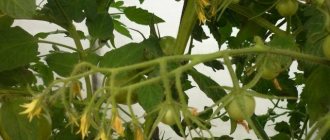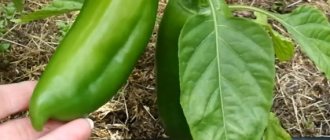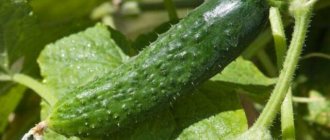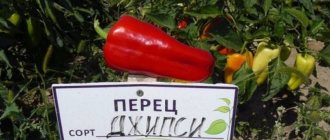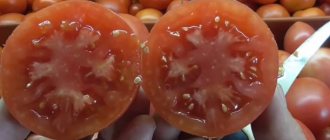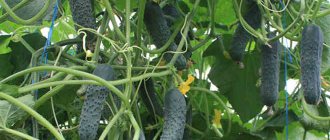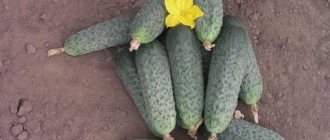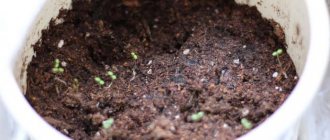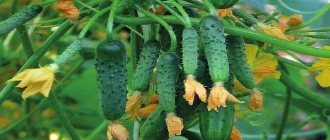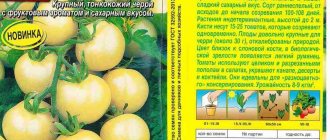General characteristics
Cucumbers Maryina Roshcha f1 were bred by breeders from Russia.
The variety is suitable for cultivation in all regions of the country. Depending on the climate, planting is carried out in a greenhouse or open ground.
Description of the plant
The first generation hybrid has an indeterminate type of development, but pollination occurs in a parthenocarpic way. The height of the bush reaches 2.5-3 m. The foliage has a rich green color. On 1 bush there is a large amount of foliage, moderate climbing type, which makes it easy to harvest a ripe crop. Number of ovaries - 2-8 pcs.
The fruits ripen 40-45 days after planting. Flowers have a female type of development. There are a large number of side shoots, so it is important to form a bush of 1 stem. Side shoots are removed.
Description of the fruit
Cucumber Maryina Roshcha f1 is characterized by high yields: from 1 sq. m, about 12 kg of selected cucumbers are collected. The length of an individual cucumber reaches 12-15 cm. On the surface of the peel there is a small number of tubercles covered with white spines. The shape of the fruit is predominantly cylindrical, but some cucumbers are more rounded at the base.
The diameter of the fruit is about 4 cm, weight is 100 g. The pulp is quite dense, without wateriness, and crispy. There is a slight sweetness, but no bitterness.
Cucumber Maryina Roshcha: description of the variety, cultivation and yield with photos
Courage cucumbers can be planted directly in the garden. At the same time, the yield will decrease, but the plants will be more hardened and their root system will develop better.
Optimal timing
The end of spring is the optimal time for sowing seeds in open ground. By this time, the soil temperature should be stable, not lower than +15 °C.
Selecting a location
The optimal place for planting is in the sun, without drafts. To provide cucumbers with comfortable growing conditions, you need to plant them in loose soil, since it easily allows water and air to pass through.
Important! Before planting, check the soil for acidity, since acidic soil will have a bad effect on the yield level of this variety. Medium loamy soil is suitable
Planting pattern and depth
Cucumbers of this variety are grown in two ways:
- When growing horizontally, seeds are placed at a distance of 40 cm, 3-4 pieces in a hole to a depth of 2-4 cm. Sprinkle the top with loose soil and cover with film until germination. After the first sprouts appear on the surface, the film must be removed and the seedlings thinned out. Avoiding strong thickening, the cucumber vines are evenly distributed on the surface of the bed.
- When growing vertically, supports are placed near the bushes, to which the plants cling with tendrils. With this method, sowing is done not in holes, but in grooves, the distance between which should be about 1 m. The sowing depth is 2.5–3 cm, the distance between the seeds is at least 15 cm. After germination, the cucumbers need to be thinned out (the gap between two neighboring plants - 35 cm).
Features of planting and care
As indicated in the description of the Maryina Roshcha tomato, they are intended for growing in greenhouses. Therefore, the crop is planted in the form of seedlings in protected soil. The tomatoes should be 55–60 days old at this point. The seeds are sown around the end of February, and planting is carried out in late April.
In stationary heated greenhouses, tomatoes of this variety can be grown all year round. To do this, the following must be taken into account:
- The soil should be light, loose, and fertile. Since vegetable crops are planted in heifers in the same place year after year, it is necessary to fertilize the soil before the procedure.
- It is advisable to use superphosphate and other complex preparations as mineral supplements.
- It is advisable to use humus as organic fertilizer.
- Tomatoes prefer fertile loam. But sandy and peaty soil is not suitable for greenhouse conditions, since in the cold season the soil quickly cools down, and in the hot season it heats up greatly in a short time.
- Seedlings are also germinated in loam. The acidity of the substrate is not particularly important.
- Grown plants should be picked and hardened.
- They are planted in a greenhouse along with the lump of earth in which they grew.
Young plants of the Maryina Roshcha variety are quite demanding in terms of conditions. When seeds germinate, an air temperature of +16 °C is allowed. However, for further full growth and development, it will be necessary to maintain a temperature of + 26–24 ° C during the day, and at night – not lower than + 18 ° C.
According to reviews and recommendations from experienced gardeners, caring for Maryina Roshcha f1 tomatoes consists of the following steps:
- timely watering;
- feeding;
- temperature control in the structure;
- formation.
An indeterminate tomato bush begins to shoot when it has 7–8 leaves. In such species, lateral shoots form much faster than the fruit ovary. Since the bush develops throughout the season, it needs to be cared for until the end of the growing season. Stepchildren should be cut off every week until the shoots reach 5 cm, otherwise the procedure will be useless.
When the fruits begin to ripen, the stems should be tied to a vertical support, and then to the brush.
Attention! From the reviews and photos of those who planted the Maryana Roshcha tomato, it follows: the lower tops on the bush are removed, thus, the nutrients will go to the formation of the ovaries. Water the vegetable crop twice a week, preferably with warm water
The soil should be slightly moistened, but at the same time, an excess should not be allowed. During the growth period, tomatoes need to be fed every 10 days. Liquid fertilizers are best combined with watering. It is advisable to alternate root feeding with spraying
Water the vegetable crop twice a week, preferably with warm water. The soil should be slightly moistened, but at the same time, an excess should not be allowed. During the growth period, tomatoes need to be fed every 10 days. Liquid fertilizers are best combined with watering. It is advisable to alternate root feeding with spraying.
When growing tomato crops in greenhouse conditions, do not forget to weed the beds, removing weeds, loosen the top layer of soil, ventilate the greenhouse, and carry out preventive spraying of the plants.
Features of agricultural technology of the variety
When planting by seedlings, you need to plant the seeds in peat pots with garden soil, and then plant the seedlings directly into the soil. With this method, the root system of the sprouts is not damaged. Deepen the seeds into the holes no more than 1.5 cm.
Before sprouts germinate, the temperature in the room should be about 24 degrees. When the main part has already sprouted, the temperature must be reduced to 15-16 degrees. From the moment the seeds germinate until the first cucumber ripens, it takes about 40-45 days.
Sowing begins in April-May, but the harvest can be harvested from July to August.
It is recommended to start planting directly into the ground no earlier than mid-May to ensure that the threat of frost is avoided.
Planting density when grown in a greenhouse is 2.5 plants per m2, in open ground 3-4.
Complex of care procedures:
- Mandatory evening watering, every three days.
- Weeding.
- Fertilizing with mineral and organic fertilizers, it is advisable to alternate them. 4 stages: 3 weeks after planting, at the moment the first gherkins appear, the next 2 feedings should be carried out every 2 weeks after the previous one.
- Loosening the soil must be done very carefully so as not to accidentally damage the stem. By loosening, the crust on the soil is removed, which interferes with the passage of oxygen to the root system of the plant.
Description
The hybrid belongs to the category of parthenocarpic, that is, it does not require pollination by insects (the ovaries grow without fertilization), which ensures the simultaneous filling of a large number of fruits, high yields and an even presentation of the greens.
Source: https://semechka.su/uhod/ogurcy-marina-roshcha-otzyvy-foto.html
What are parthenocarpic hybrid cucumbers?
On packages of vegetable crops (including cucumbers) the inscription “parthenocarpic hybrid” is often found. But not all vegetable growers know what this means. Most often it is believed that such plants pollinate independently, without the participation of insects. This opinion is not correct. In such vegetables, fruits are formed without pollination at all.
When plants self-pollinate, seed material is necessarily formed in the fruits. But the fruits of parthenocarpic hybrid varieties do not form seeds.
Such plants are most suitable for growing in greenhouses, because insects usually do not get there.
Summer residents, appreciating the many advantages of such vegetable crops, are happy to grow them in beds or in greenhouses. And if the first parthenocarpic varieties were intended for fresh consumption of ripe fruits, now new hybrids have appeared that are excellent for preservation.
- fruits ripen throughout the season;
- gherkins ripen quite quickly;
- resistance to adverse weather conditions;
- cucumbers have a pleasant taste and are free from bitterness;
- high resistance to most diseases; if affected, it is easy to cope with the disease;
- no need for pollination;
- ripe cucumbers - the same size and uniform color;
- a number of hybrids are suitable for pickling and preservation;
- the harvested crop is stored for a long time without losing its marketability and taste, and tolerates transportation well over long distances;
- When overripe, cucumbers do not lose their even green color.
Description and main characteristics of the hybrid Maryina Roshcha
Cucumber Maryina Roshcha is a high-yielding bunch gherkin hybrid that produces only female flowers. This variety can be planted in beds in open ground, under film coverings, or in glazed greenhouses. The yield in greenhouses will be much higher than in garden beds.
The quantity and quality of the harvested crop is not affected by unfavorable weather conditions during the season; ripe cucumbers can be harvested almost before the first frost on the soil. Maryina Roshcha is a plant with long vines, the height of which can reach 1.8 - 2.2 m. The shoots grow lateral stems well, the hybrid can continue to bear fruit at temperatures close to 0. The hybrid requires mandatory tying to the trellises of the main shoot.
A description of the variety would be incomplete without a story about the fruits. Each node can form up to 5 ovaries. At the same time, up to 12 cucumbers can ripen on each bush of Maryina Roshcha. The fruits are small in size, which is why they are called gherkins, the length of ripe cucumbers is no more than 12 cm, the color is soft emerald, the skin is quite dense, covered with white tubercles and spines.
Ripe gherkins are suitable for fresh consumption and for preservation. The taste of salted or pickled Maryina Roshcha cucumbers is no worse than fresh ones.
Transportability characteristics: the harvested crop can be safely transported over long distances - the cucumbers will not lose their excellent presentation and good taste. The keeping quality of collected cucumbers is high - the fruits can be stored fresh under appropriate conditions for up to 2.5 - 3 months.
Hybrid Maryina Roshcha is highly resistant to the following diseases:
This vegetable crop tolerates the following diseases quite easily:
- downy mildew;
- all types of root rot.
Cucumber Maryina Roshcha f1: description and characteristics, reviews
The Maryina Roshcha hybrid has gained popularity due to its excellent taste characteristics and high yield. This is a multi-purpose greens plant. They are used for preparing salads, as well as for making preparations. The plantings are easy to care for; they bear fruit well even in the open air.
general description
Marina Roshcha f1 belongs to the parthenocarpic gherkin early-ripening hybrids. The harvest can be harvested 40-45 days after emergence. The peculiarity of the variety is that the plant pollinates itself. The plant is high-yielding. Temperature changes and bad weather have virtually no effect on productivity.
The hybrid was bred by Russian breeders. To enhance the positive characteristics, 2 varieties were crossed. Designed for cultivation in any climatic conditions of the country. Depending on the weather conditions of the area, the planting method differs (open ground or greenhouses).
Parthenocarpic varieties are distinguished by the fact that they produce exclusively female flowers.
Climatic conditions do not affect crop productivity. You can harvest until frost. If you follow the growing rules, the productivity of 1 bush is up to 12 kg. They are often grown for trade and on a production scale, since vegetables perfectly retain their presentation and taste during transportation.
The variety is resistant to most cucumber diseases.
Description of the bushes
Maryina Roshcha is a plant represented by long vines. They reach up to 1.8-2.5 m. They require tying and proper formation of bushes. Maryina Roshcha is a first generation hybrid. The bushes have an indeterminate type of development.
Each bush is distinguished by an abundance of foliage and moderate branching. Vertical supports are used to grow crops. Form the plant into 1 stem, removing the side shoots.
Description of fruits
Cucumbers are formed on vines, 4-8 pieces in each node. Up to 12 identical greens are collected from each vine at the same time.
The fruits are gherkin type and small in size (up to 12 cm). Average weight - 100-110 g. Diameter is about 3 cm. The peel is dense, with tubercles, with white thorns on them. Zelentsy have a soft emerald color. The ribbing is weak.
The flesh is dense and crispy. Used fresh or for pickling and canning. The taste qualities after heat treatment practically do not change. The taste is sweet-cucumber with a bright aroma.
Advantages and disadvantages
Like any plant, the Maryina Roshcha cucumber species has its positive and negative sides. Among the main advantages are:
- excellent taste characteristics;
- resistance to cold and temperature changes;
- versatility of use (fresh or for canning);
- many fruits on one bush;
- good shelf life and transportability;
- long fruiting period;
- grows well in different conditions (greenhouses, open ground, windowsill);
- immunity to most cucumber diseases.
The main disadvantage of these plants is that the lashes require mandatory tying (due to their large length) and shaping. If there is insufficient watering, greens may become slightly bitter.
Landing Features
For areas with a warm climate, they are planted in open ground. If weather conditions are not too favorable, then Maryina Roshcha is grown in greenhouse conditions.
Planting takes place in late April - early May. By this time, the soil should warm up to 15 degrees and the likelihood of spring frosts should disappear. The planting depth is 3.5 cm. A distance of 50 cm is maintained between bushes and rows.
If you use the seedling method of growing, then the width of the hole is made 1-2 cm wider in diameter than the container with the seedling.
Plant seedlings on a cloudy day or in the evening. This will help eliminate the possibility of burns on the leaves. The seedlings are transplanted using the transshipment method.
Basic rules of care
Growing the Maryina Roshcha hybrid does not differ from the rules for caring for other similar crops. To get a harvest you need to follow the standard rules.
- Watering. Cucumbers are a moisture-loving crop, so water the plants regularly. The water should be at room temperature; it is best to use settled rainwater.
- Loosening. A mandatory procedure that helps cope with harmful microorganisms. Loose soil allows oxygen and water to pass through faster. Do not immerse the teeth of the tool to a great depth, since the roots of cucumbers are superficial and may be damaged.
- Weeding. The presence of weeds in the garden bed quickly leads to damage to cucumber plantings by diseases and infections, as well as soil oxidation. In the absence of weeds, micronutrients reach the plant faster.
- Feeding. Fertilizers are applied every two weeks. Various organic and mineral compounds are used.
It is important to harvest the crops on time. If you leave ripe cucumbers on the vines, the formation of new ovaries is stopped.
Diseases and pests
The Maryina Roshcha hybrid is not susceptible to most diseases that are characteristic of other varieties and types of cucumbers. Culture is not afraid:
- cucumber mosaic;
- powdery mildew;
- spotting.
Greenhouse plants are most susceptible to fungal diseases. Defeat occurs for several reasons:
- improper formation of the bush;
- dense plantings;
- poor ventilation, stale air;
- improper watering.
But pests can cause significant damage to plantings. The most dangerous are spider mites and May beetle larvae. If insects appear on one bush, then treatment is carried out immediately. Special chemicals are used.
To combat pests, folk recipes are used: a solution of laundry soap, an infusion of walnut leaves, garlic or red hot pepper.
Reviews
Oksana, 43 years old
“I buy hybrid types of cucumbers for planting. They bear fruit better than varietal representatives. This is not the first year I have been planting Maryina Grove. The result is amazing, a good harvest every year. I use it for preservation and pickling.”
Vladimir, 54 years old
“I’ve been growing the hybrid Maryina Roshcha for the second year in a greenhouse. Before planting seedlings, vertical supports from a trellis are installed. I always form the growth of bushes into 1 stem, removing part of the lower foliage to make it easier to monitor the condition of the plants. Last year I weighed the harvest for fun. The maximum we managed to get from one plant was 11.7 kg.”
Alexandra, 38 years old
“I bought Maryina Grove for the first time and now they only buy parthenocarpic gherkin hybrids. The harvest is amazing, the plants do not react strongly to climatic disasters, and do not depend on pollinating insects.”
When growing Maryina Roshcha f1 cucumbers, gardeners rarely encounter problems. The culture is undemanding; with proper standard care, a large harvest of cucumbers is guaranteed; the main thing is to take into account the characteristics of the plant.
Source: https://zemeljka.ru/ogurec-marina-roshha-f1.html
Advantages and disadvantages
In addition to the above advantages of parthenocarpic hybrid cucumbers, specific advantages of Maryina Roshcha should be noted:
- resistance to significant temperature drops;
- a sufficiently large number of simultaneously ripening cucumbers on the shoots;
- the possibility of growing in protected ground and on a windowsill, since the variety does not require pollination by bees;
- the harvest can be used for salting and pickling;
- high resistance to most diseases.
The hybrid has practically no disadvantages. It should be noted that the vines of this cucumber crop require obligatory garter using the trellis method.
Description of the Maryina Roshcha cucumber and recommendations for growing the variety
Cucumber Maryina Roshcha F1 is one of the best vegetables presented in this segment. Experts recommend growing the variety in open and protected ground. The hybrid is an early ripening species. By growing the presented gherkins in greenhouse conditions, the gardener can harvest the harvest much earlier than if he plants the plant in an open area.
What is the Maryina Roshcha cucumber?
Let's look at the description of the Maryina Roshcha variety. The yield of these cucumbers is not satisfactory: reviews from experienced farmers say that a large number of ripe fruits can be collected from 1 bush of the plant, while cucumbers from a greenhouse bear fruit much better. It is important to understand that the Maryina Roshcha cucumber variety is characterized by the formation of only female flowers.
Cucumbers are highly resistant to adverse environmental conditions. Throughout the season, the gardener can collect ripe fruits from the bush, and the fruiting period ends only with the onset of the first frost. The variety is a plant with fairly long vines; their height can even reach more than 2 m.
A large number of lateral shoots are formed from the shoots, and the plant can bear fruit down to zero air temperature. It is important to follow one of the rules for growing the presented variety - tying the main stem to previously prepared supports.
Description and characteristics of the variety
The hybrid from the originator "Manul" has fruits with the following characteristics:
- length 10-12 cm;
- weight within 100 g;
- diameter no more than 3 cm;
- neat, elongated shape;
- weak ribbing;
- the pulp is juicy, crispy;
- elastic consistency;
- the skin is bright green.
Zelentsy is used in fresh dishes and for winter preparations (salting, canning). The fruits have excellent pickling properties.
